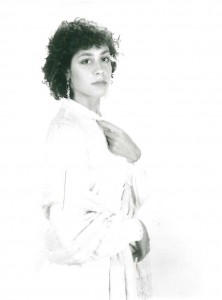By: Becky Larson
Jessica Crawford, City of Lake’s Waldorf School’s grade 1 teacher was readily recognizable to many of you in this portrait! In a wonderful coincidence, Donna Webb, artist and Novalis Institute teacher, was the one to take this portrait of Ms. Crawford 25 years ago – before either one of them had discovered Waldorf education.
Jessica was working the jewelry counter at her mother’s shop- The Raven Art Gallery. Donna was a photographer and artist who worked as a framer there. She asked Jessica to pose for this portrait as a response to Titian’s St. John the Baptist– can you see the references?
I asked her what she remembered about the day they created this image, and she said, “I liked her house, it was intriguing. She was such an interesting, independent woman and artist. Much later, I ended up taking some watercolor painting classes from her at Novalis.” By then, both women had already discovered Waldorf education independently.
Jessica first encountered Waldorf inspired ideas through art history. She was fascinated by Wassily Kandinsky and the Russian artists inspired by theosophy, which anthroposophy later broke away from. She earned a Master of Fine Arts from the University of Oregon, Eugene, and an interdisciplinary Bachelor of Arts from St. Olaf and then taught design and photography at St. Kate’s for many years.
When it was time to take her eldest child to school, a friend introduced her to Waldorf Education, and everything clicked. She immediately began reading voraciously and took several introductory anthroposophy classes. “Everything just made sense to me. It was things I was already doing, like creating a healthy rhythm, simplifying, giving them natural materials to play with- so it felt right and easy,” she says. She found the Waldorf approach instantly useful in her role as a mother. “It was a way of being with my children at home- outside time, simplicity, and keeping them away from hyper-intellectualism when they’re little,” she says.
Jessica began teaching at City of Lakes Waldorf School as co-teacher in grade 7, leading them through graduation. She became the handwork assistant in 2004, eventually taking the role of lead handwork teacher, and running Little Sprouts for a time. She went back to lead teaching full-time with last year’s eighth grade class. It was the students themselves who asked her to lead their classroom. She had been teaching them pinhole photography and they brought the question to her one day in the darkroom while they were processing pictures. “It was their idea for me to teach them,” she says, “They asked me in the dark, where it was safe.”
After graduating those eighth graders last June, she began with the first graders she will guide through their next eight years at City of Lakes Waldorf School. I asked about the challenge of moving from capable 14 year-olds to 7 year-olds who need help tying their shoes. She says it’s a bit of both, pointing out that the eighth graders may be able to tie their shoes, but they also know how to hold grudges.
“In first grade with social conflicts, I get them together and have them hold hands and say, ‘Ah, that must have hurt when he did that,’ and ‘what can you do to help them feel better?’ and they say, ‘Oh! I can make them a card!’, and I say, ‘good idea,’ and off they go and it’s done! It’s over.”
Enthusiasm, and an earnest openness are among her favorite characteristics of first graders. “They have one foot in this world that I’m not at all a part of as an adult,” she says. She describes watching them unconsciously writing their names completely backwards. “If I held up a mirror, it would be completely correct, but every single letter and the order is exactly reversed, and they don’t even know they did it!” she says with a grin. They are still developing their understanding of which things come first and which things come after, and this time is so precious and fleeting. “It’s completely gone by the time they are nine,” she says.
For Halloween she arrived in class as Miss Adelaide- Ms. Crawford’s identical cousin. The two look exactly the same, except for Miss Adelaide’s blonde hair. She had great fun watching them discover this new lady, and how easily they accepted the pretense. They were quite exacting too- noticing that Miss Adelaide and Ms. Crawford both wear the same tiny silver watch. She simply said, “Ah, yes, isn’t that funny, we have different hair, but we wear the same watch!” And their openness and earnestness allow them to accept it totally.
“It’s such a gift- I remember when my own children were this age I used to think, ‘Can’t you please stay exactly like this?’, but of course, you want them to grow and change and discover…” All the more reason to be present to them every day, to fully appreciate the way they are working, thinking and existing today.
She says that in every classroom, there is a beautiful exchange that happens between teacher and student. “It’s this meditation in the moment, right there as I’m giving the lesson, I’m watching them to see how it’s going. Are they fidgeting? Are they engaged? Are they ready for this? Should I slow down, or speed up? Give them this, give them something different?”
“I think they can feel what it is that I love to bring to them. It could be anything- color, the number two, playing with language- their enthusiasm comes back to me and so it’s a dance, a back and forth- and it’s so fun to think that it’s only just started!” She will have eight more years with this class, to learn about each student’s temperament, ways of learning and special talents.
“Just getting a feeling for who each person is, intuitively,” helps her to know which movements will be right for the group, or whether this drawing is too simple, or too complicated for this student or that student. She will also get to know their parents deeply in the next 8 years, as they watch the children grow up together. “It just feels very much like a community that has been added to my life,” she says.
She loves the challenge of being a classroom teacher, and the requirement to delve deeply into subjects to bring them to her students. This sometimes means learning a subject in order to teach it- like chemistry for her eighth graders. “I didn’t take chemistry in college, so I learned for myself and then figured out how to give it to them in a meaningful way,” she says.
Being a Waldorf teacher has been a tremendous enrichment to her life because it demands so much personal growth. “It’s such an unusual opportunity to get to do this as a human being. I can’t think of any other occupation that requires me to transform in this way. This recapitulation of human evolution is the curriculum requiring me to grow. I’ll never do that lesson again, but it’s the same children again, and there is another day, another day to continue to work with the material, and with them and with my own understanding of the material. ” This sounds like a complex and delightful dance indeed.


